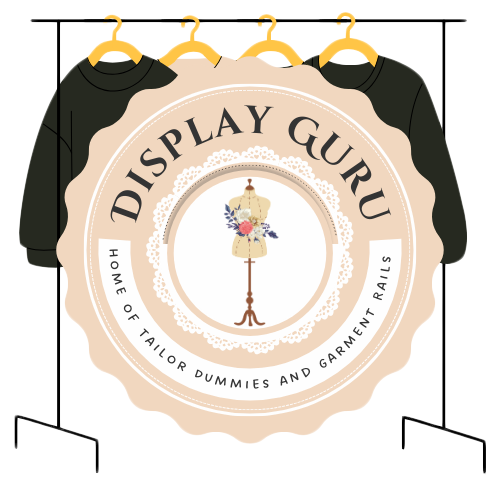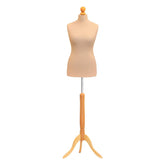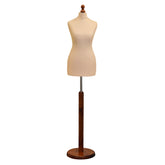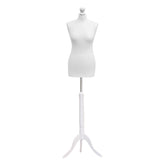What Is Bespoke Tailoring? Discover the Art of Custom Suits
So, what exactly is bespoke tailoring? At its heart, it’s the time-honoured art of crafting a garment completely from scratch for one individual. This isn't about adjusting a pre-existing template; it’s about starting with a blank canvas, your measurements, and the tailor's seasoned expertise.
The Art of Bespoke Tailoring: Beyond a Perfect Fit

Think of it this way: you could ask a builder to modify a standard house plan, or you could commission an architect to design a home that's uniquely yours. The first is what we call ‘made-to-measure’—a perfectly fine approach. The second, however, is truly bespoke, a one-of-a-kind creation designed from the ground up. This fundamental difference is where the magic really happens.
The entire process is a close collaboration between you and your tailor. It involves drafting a paper pattern that will only ever be used for you, followed by countless hours of meticulous hand-stitching and a series of fittings to sculpt every line and curve. The result isn't just a suit that fits you flawlessly; it’s a garment that becomes a second skin, one that mirrors your posture, tastes, and personality.
The Hallmarks of a True Bespoke Garment
What really sets a bespoke piece apart? It all comes down to a few non-negotiable elements that define the craft in its purest form:
- A Unique Pattern: A fresh paper pattern is hand-drawn and cut for every single client. This becomes the one and only blueprint for their garment.
- Multiple Fittings: The suit is built in stages, meaning you’ll come in for at least two or three fittings, and often more, to get the fit just right. The first is usually a ‘basted’ fitting, where the suit is held together with temporary stitches for the initial, crucial adjustments.
- Artisanal Handwork: From the hand-padded lapels that give the chest its shape to the precisely hand-sewn buttonholes, a huge amount of the work is done by hand. This allows for a level of detail and shaping that a machine simply cannot replicate.
A bespoke suit is not merely clothing; it's a wearable piece of art. The process honours centuries of tradition, where the relationship between the client and the artisan is as important as the final product itself.
The term itself has been the subject of some debate. Back in 2008, a key ruling by the UK's Advertising Standards Authority (ASA) clarified its use. The ASA concluded that suits cut and sewn by machine could still be advertised as 'bespoke' if they were made to order. This acknowledged a broader definition than the purist, fully hand-crafted approach. You can get more details on this ruling and its nuances on Wikipedia, where it helps distinguish the term from made-to-measure.
The Heritage of Bespoke: From Savile Row to Global Icon
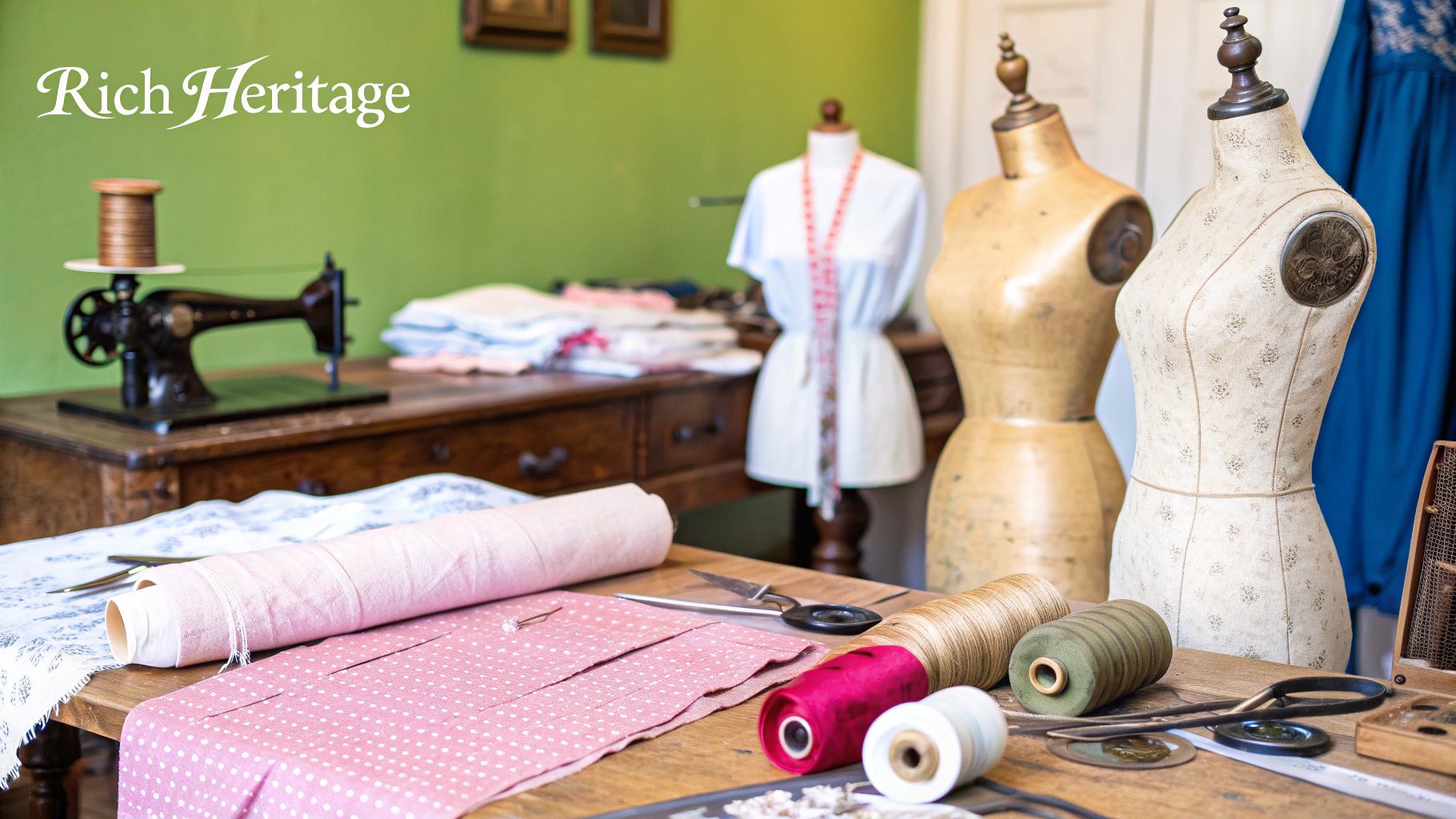
To really understand what makes bespoke tailoring so special, you have to go back to where it all began: London's legendary Savile Row. The craft as we know it was born on this street during the 18th and 19th centuries, driven by the exacting demands of the British aristocracy and high-ranking military officers. These men needed more than just clothes that fit; they required garments that performed flawlessly and were built to last a lifetime.
This created a style that was distinctively British. While tailoring on the continent often leaned towards decorative flair, English craftsmanship became known for its clean lines, structured shoulders, and an air of quiet confidence. It was clothing with a purpose, designed to project authority and class without shouting about it.
It was these traditions, established on one small London street, that set the global standard for men's formalwear. Savile Row wasn't just a place to buy a suit; it was the undisputed heart of the tailoring world, where craftsmanship was treated as a true art form.
The Golden Mile of Tailoring
The deep-rooted history of bespoke tailoring in the UK is tied directly to Savile Row, a street still known as 'the golden mile of tailoring.' As the British Empire grew in power and wealth through the 18th century, so did the appetite for exceptional clothing. By the early 1800s, a suit from a Savile Row tailor was already the ultimate symbol of quality in menswear, defining the look of English business attire for the rest of the world.
This legacy has carved out a unique and deeply respected place for the British tailoring industry. Today's workshops are the custodians of that heritage, continuing a tradition of painstaking precision. The level of skill involved is truly immense. Master cutters and tailors spend decades perfecting their work, learning not just how to measure a body, but how to read a client’s posture and express their personality through fabric. It’s this profound dedication that has kept the Savile Row tradition alive and well.
The legacy of Savile Row is more than just a postcode; it's a philosophy. It stands for a commitment to individual expression, uncompromising quality, and the timeless power of a perfectly made garment.
That philosophy continues to shape style across the globe. The core principles of balance, proportion, and meticulous construction that were perfected in London remain the bedrock of high-end menswear everywhere. The expertise needed to uphold these standards also demands that every workshop operates with incredible precision. For anyone fascinated by the craft, having a look at some effective sewing room organisation ideas can offer a small window into the discipline behind the artistry.
From a single London street to a worldwide icon, the heritage of bespoke tailoring remains a powerful symbol of British craftsmanship and enduring elegance.
Your Bespoke Journey: From First Consultation to Final Fitting
Stepping into the world of bespoke tailoring is nothing like buying clothes off the rack. It’s a genuine collaboration, a creative partnership where your personal style and the tailor's deep expertise are woven together. The entire process unfolds over several weeks, a meticulous dance of consultation, creation, and refinement.
It all kicks off with the initial consultation. This isn't just a quick chat; it's a deep dive into your lifestyle, your tastes, and what you need the garment to do for you. Together, you'll pore over bolts of fabric—from hardy British wools to breezy Italian linens—and discuss every single detail, from the cut of the lapel to the angle of the pockets. This first conversation is the bedrock of the whole project.
This image charts the course, from the moment the measuring tape comes out to the final, finished piece.
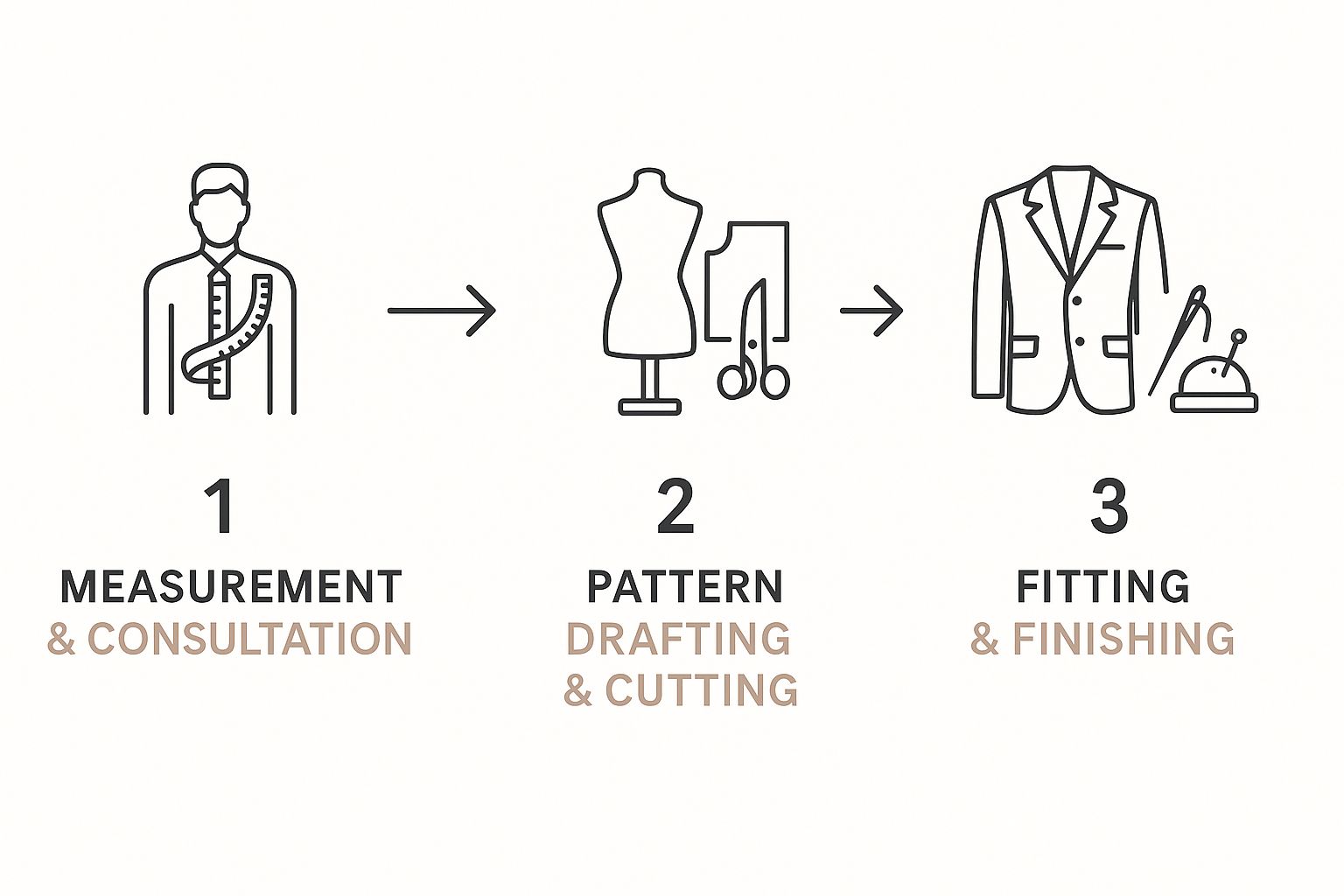
As you can see, it’s a structured journey. Each stage must be perfected before the next can begin, ensuring nothing is left to chance.
From Measurements to a Paper Pattern
Once the vision is clear, your tailor will take a comprehensive set of measurements—often 20 to 30 of them. These aren't your standard chest and waist numbers. They capture the subtle nuances of your posture, the slope of your shoulders, and how you naturally stand. This data is then translated into a unique paper pattern, drafted entirely from scratch.
This pattern becomes your personal sartorial blueprint. It is unique to you and will be kept on file by the tailor for any future commissions, guaranteeing that same flawless fit time and again.
With the pattern ready, the cutter chalks it out onto your chosen cloth before making the first, irreversible cuts with heavy shears. It’s a moment of pure skill where precision is everything. The cut pieces are then loosely tacked together with white thread, creating a basic shell of the garment, ready for its first crucial meeting with you. For a deeper understanding of how tailors capture body shapes, it's interesting to see how tools like adjustable dress forms for sewing are used to achieve that perfect silhouette.
The Critical Fitting Process
The fittings are where the magic really happens, where the cloth starts to feel like a second skin. While a made-to-measure suit might only require one fitting, the bespoke process demands at least two or three to get things absolutely spot on.
-
The Basted Fitting: This is the first time you'll try on the garment. It will be a mere skeleton of the final suit, held together by temporary basting stitches. Here, the tailor assesses the balance, drape, and proportions, making bold chalk marks directly onto the fabric to guide the next set of alterations.
-
The Forward Fitting: After the first fitting, the suit is completely taken apart and recut based on the chalk marks. It's then re-sewn more substantially. This second fitting is for fine-tuning the silhouette, checking the armhole comfort (the sleeve pitch), and ensuring the collar sits perfectly. It’s all about comfort and creating clean lines.
-
The Final Fitting: By now, the suit is almost finished, with details like buttonholes and pockets in place. This is the last chance for any minor tweaks before the garment gets its final press. After this, it’s ready for you to take home and wear with pride.
The True Value of a Bespoke Suit
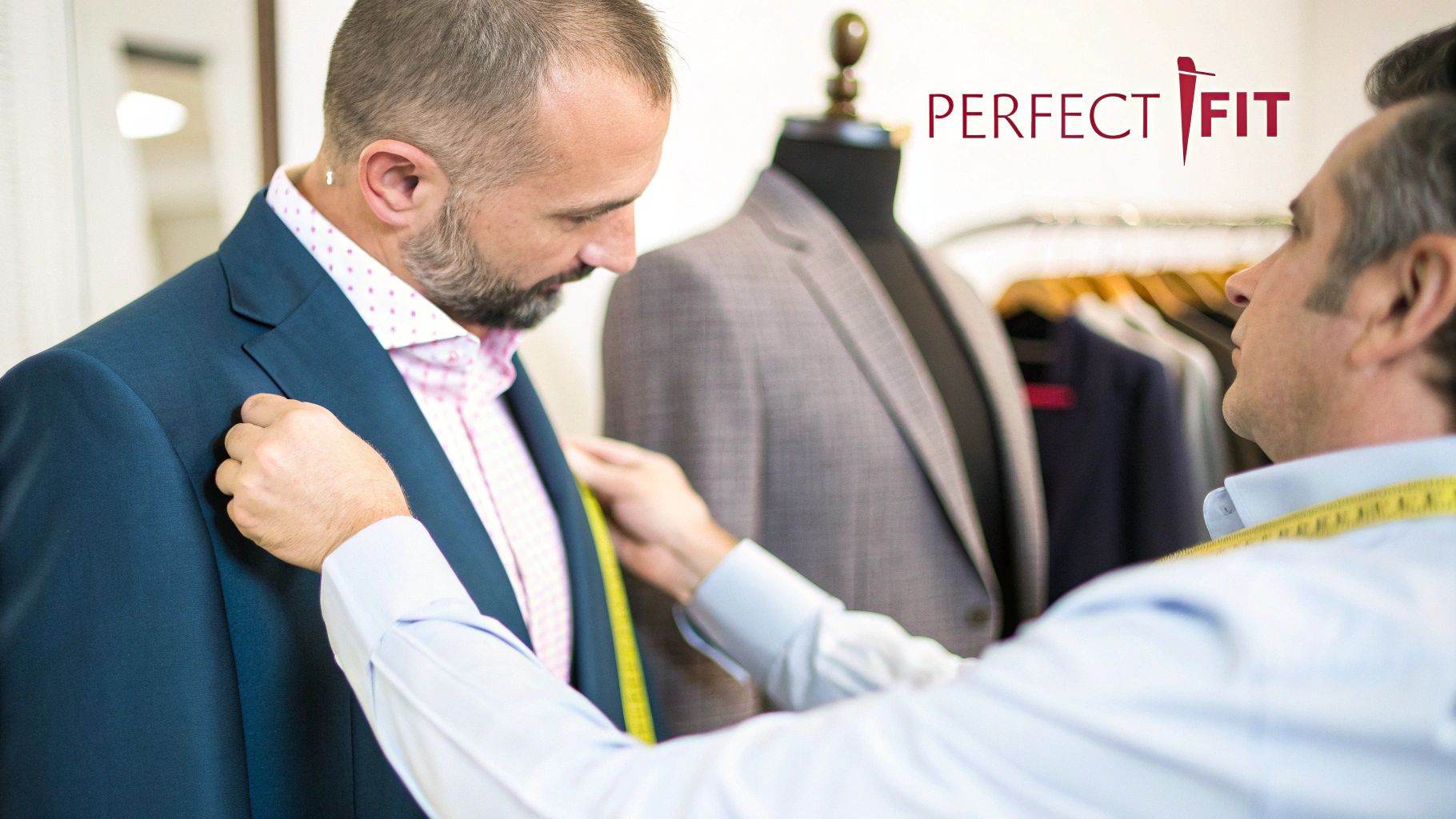
So, beyond that perfect fit, what really makes a bespoke suit worth the investment? The value goes so much deeper than just the measurements. It’s about a kind of comfort you've likely never experienced, a longevity that defies fast fashion, and a unique expression of you that simply can't be bought off the peg.
Think of it as commissioning an item built for a lifetime, not just a passing season.
A bespoke garment moves with you, not against you. Because it's drafted from scratch based on your unique posture and the way you stand and move, there’s no awkward pulling at the shoulders or tightness across the back. The feeling is one of complete freedom—something mass-produced clothing can never quite match.
An Investment in Longevity and Style
One of the strongest cases for going bespoke is the sheer lifespan of the garment. These suits are built to last. We're talking superior materials and meticulous hand-stitching, with features like a full-canvas construction that helps the suit gently mould to your body over years of wear.
This focus on quality also makes a bespoke suit a profoundly sustainable choice. Instead of churning through ill-fitting clothes every few years, you're investing in a cornerstone piece that, with a little care, can serve you for decades. It's the very essence of "buy better, buy less." When you break it down, the cost-per-wear often turns out to be remarkably reasonable in the long run.
A bespoke suit isn't an expense; it's an asset. It’s a commitment to enduring quality and personal style that pays dividends in confidence and comfort every time you wear it.
The Ultimate Personalisation
Perhaps the greatest joy of the bespoke process is the endless scope for personalisation. This is where your individual style truly comes to the fore. Every single element is up for discussion, allowing you to create something that is genuinely one-of-a-kind.
- Fabric Selection: You’ll have your pick of thousands of cloths from the world's most renowned mills, letting you choose the ideal weight, colour, and texture.
- Design Details: You get to dictate the style of the lapels, the slant of the pockets, the number of buttons, and even the felt colour under the collar.
- Finishing Touches: Why not select a vibrant, unique lining that only you know is there? Or opt for functional "surgeon's cuffs" on the sleeves? You can even add subtle, embroidered initials for a private, personal mark.
Pulling all this together requires a true artisan who can translate your ideas into a perfectly fitting garment. An essential part of that process is making sure every detail conforms to the human form, a skill detailed in this male tailor dummy guide. At the end of the day, the real value lies in creating something that is exclusively, authentically yours.
The Artistry Inside the Suit: Materials and Techniques
To really get to the heart of what bespoke tailoring is, you have to look past the perfect fit and into the very soul of the garment. The true magic happens in the materials chosen and the time-honoured techniques used to bring them together—a world away from mass-produced clothing. It all starts with the cloth, often sourced from legendary British and Italian mills that have been perfecting their craft for centuries.
The choice is staggering, from hardy tweeds and worsted wools to lightweight linens and luxurious cashmeres. Each fabric has its own character, its own way of draping, and its own feel. The artistry isn't just in what you see, but in the small details, like the quality and composition information you'll find on the suit's custom material clothing labels. This initial choice of fabric is the first, crucial step in creating something that isn’t just beautiful, but perfectly suited to the wearer’s life and purpose.
The Full Canvas Construction
At the core of any truly great bespoke suit is its full-canvas construction. Picture a hidden layer of horsehair canvas, carefully stitched between the suit fabric you see and the lining on the inside. This layer is what gives the jacket its shape, its structure, and its incredible lifespan. Unlike the cheaper, glued-on interfacing found in off-the-rack suits, a full canvas is stitched in loosely, allowing it to "float."
What this means is that over time, the canvas actually moulds to your body's shape, creating a fit that gets better with age. It’s what helps the lapels achieve that beautiful, natural roll instead of a flat, lifeless press. This internal architecture is a non-negotiable hallmark of true craftsmanship, delivering a blend of durability and comfort that machines simply can't copy. A proper construction is essential, and our guide on adjustable manufacturing tailoring delves deeper into how precision fitting shapes the final piece.
The full canvas is the suit's skeleton. It provides the structure that allows the garment to drape correctly and move with you, becoming a true second skin rather than a rigid shell.
Handwork Machines Cannot Replicate
The most significant difference, though, lies in the meticulous handwork that defines bespoke quality. This human touch gives the garment a softness and three-dimensional quality that modern machinery could never hope to achieve.
- Hand-Padded Lapels: Tiny, invisible stitches are used to form the lapels, giving them a gentle, elegant curve that sits perfectly against the chest.
- Hand-Sewn Buttonholes: Each buttonhole is cut first, then meticulously sewn with silk thread. This creates a strong, beautiful detail that is an undeniable sign of a handmade garment.
- Artful Pressing: Using a heavy iron and bursts of steam, the tailor masterfully shrinks and stretches the wool, sculpting it into a three-dimensional form that follows the natural curves of the body.
This steadfast resistance to mechanisation is a core part of the craft. The prestigious firms on Savile Row are famous for their strictly hand-crafted approach, keeping individual customer patterns on file for decades. This dedication to manual skill isn't just about sticking to tradition; it’s about achieving a superior result that honours both the client and the cloth.
Your Bespoke Tailoring Questions, Answered
Stepping into the world of bespoke for the first time can feel a little intimidating. It's only natural to have questions about how it all works, especially when it comes to time, cost, and finding the right person for the job. Let's clear up some of the most common queries so you can start your journey with confidence.
How Long Does a Bespoke Suit Take to Make?
In bespoke, patience isn't just a virtue; it's a necessity. This isn't a rushed process. We're talking about meticulous craftsmanship, where perfection is the only goal. As a rule of thumb, expect the entire journey to take anywhere from 8 to 12 weeks, from your first chat to walking out with the finished suit.
That timeframe gives the tailor the space needed for every crucial step: discussing the design, taking detailed measurements, sourcing your fabric, and, most importantly, hand-drafting a unique paper pattern just for you. It also covers the series of fittings that are essential to shaping the suit perfectly to your form.
Within this period, you’ll typically have a few key appointments:
- The Basted Fitting: Your first look at the suit, which is loosely stitched together. This is where major adjustments to the structure and fit are made.
- The Forward Fitting: The suit has been taken apart and recut based on the first fitting. This is where we fine-tune the silhouette and ensure total comfort.
- The Final Fitting: The suit is almost finished. This is the last check for any tiny tweaks before the final hand-finishing is completed.
Of course, the final timeline can shift depending on how busy the tailor is, how complex your suit is, and even how quickly the fabric mills can deliver your chosen cloth.
What Is the Typical Cost of a Bespoke Suit in the UK?
The price of a bespoke suit can vary quite a bit. It really comes down to three things: the tailor's reputation, their location (a Savile Row address carries a premium), and the quality of the fabric you choose. Think of it as an investment in unparalleled skill and time.
For a two-piece suit from a well-regarded tailor outside of London's famous Savile Row, you can expect prices to start around £2,000 to £3,000. On Savile Row itself, the entry point is typically closer to £5,000, and for rare fabrics or more complex designs, the price can easily head north of £10,000.
This isn't just the price of a suit; it's the price of a service and an experience. The cost covers the 50 to 80+ hours of a master cutter's and tailor's time, the premium materials, and the creation of a garment that is utterly unique to you.
How Do I Choose the Right Bespoke Tailor?
This is perhaps the most important decision you'll make. Choosing a tailor is a deeply personal thing. You're not just buying a product; you're starting a collaborative relationship. It’s got to feel right.
First, do your homework. Look into different tailoring houses and get a feel for their 'house style'. Some are famous for a sharp, structured English cut with strong shoulders, while others might lean towards a softer, more natural Italian style. See whose work genuinely speaks to you.
Once you have a shortlist, book a few consultations. This is your chance to talk about what you want, but more importantly, to see how you get on with the tailor. Good chemistry is vital. You have to be able to communicate openly for the process to work.
When you meet, ask plenty of questions. A good tailor is a great listener. They should offer their expert advice without being pushy, making you feel comfortable and understood. You'll know you've found the right one when you sense their genuine passion for the craft and their excitement to bring your vision to life.
At Display Guru, we provide the professional-grade tools that artisans rely on to achieve the perfect fit. Explore our collection of high-quality tailor dummies and body forms to see the foundations of exceptional craftsmanship.
